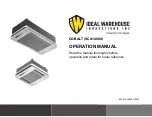
38
9.4 MOISTURE IN A REFRIGERANT SYSTEM:
The filter drier in the system removes particles and small amounts of moisture which may enter the system during minor
servicing or fault conditions. Major moisture intrusion through fault or contamination may require complete system evacu-
ation for moisture removal.
Moisture in a refrigerant system is directly or indirectly the real cause of more problems and complaints than all other
causes combined. Moisture in a system can be visible or invisible. Rarely is liquid water found in a system, normally all
intrusive moisture is in the form of vapor. A single drop of moisture in a system can cause “freeze-ups.” Moisture can be
picked up by the refrigerant and be transported through the lines as a fine mist, causing ice crystals to form at the point
of expansion (expansion valve). These ice crystals retard or stop the flow of the refrigerant, causing a reduction or
complete loss of cooling. As the expansion valve warms due to the lack of refrigerant, the ice melts and passes through
the expansion valve. The moisture then cycles through the system until it again returns to the expansion valve, and the
cycle is repeated. The result is intermittent cooling. Moisture can also cause corrosion, which can present serious
problems, often not apparent until severe damage has occurred. Moisture, combined with refrigerants, can create acids
which in turn greatly increase the corrosion of metals and copper plating.
Refrigerant oil has an attraction for moisture absorbs it rapidly if left open to the atmosphere. Water formed acids mix with
refrigerant oil, the two forming a closely bonded mixture of fine globules. The effect is called “sledging” and greatly
reduces the lubricating ability of the oil. The corrosion caused by the presence of this moisture in the form of “sludge” can
plug fine strainers, expansion valves and capillary tubes. Because it usually contains acids, sludge corrodes whatever it
clings to, accelerating system damage. Only use fresh oil from unopened containers. Previously opened oil provides too
great a danger of system moisture intrusion.
The most effective means in removing moisture from a system is to utilize a high (deep) vacuum pump. A high vacuum
pump is capable of removing all moisture from a hermetic system by reducing internal system pressures to the boiling
point of water at normal temperatures. The vacuum pump does not “suck out” the liquid moisture, but rather causes it to
boil into a vapor state at which time it can be harmlessly removed from the system and exhausted through the vacuum
pump.
The ideal vacuum pump evacuates the system to at least 500 microns and is capable of holding that vacuum throughout
the dehydration process. It pulls that vacuum on the entire system and not simply at the intake of the pump; it removes
moisture at an ambient temperature of 80°F or over.
Table- 2 provides the boiling temperature of water compared to the evacuation of a system. The higher the vacuum, the
lower the boiling point, the greater the system evacuation.
To reduce pumping time as well as prevent early pump failure, use only a pump properly sized to the system. Table-1
provides pump sizing-to-system requirements. A larger than recommended pump is perfectly acceptable, but avoid using
a smaller than recommended pump. Multiple vacuum pumps equaling the single size required may be utilized by placing
them at various points on the system. Be sure that all valves are open to allow complete evacuation of the system.
Change the vacuum pump oil every time the pump is used; clean oil enhances pump efficiency.
System Size
Suggested High Vacuum Pump Size
Up to 7 tons
1.2 CFM
Up to 15 tons
2.2 CFM
Up to 30 tons (MAC240 air conditioning system)
4.5 CFM
Up to 100 tons
15 CFM
TABLE-1: SUGGESTED HIGH VACUUM PUMP SIZE
Summary of Contents for MAC-240
Page 1: ...MOBILE AIR CONDITIONING SYSTEM Model MAC 240 INSTALLATION OPERATION MAINTENANCE MANUAL...
Page 9: ...8 D Alarms Shutdowns...
Page 15: ...14 SCHEMATIC REFRIGERATION DIAGRAM...
Page 44: ...43 10 EQUIPMENT DIMENSIONAL DETAILS Model No MAC240FZ600...
Page 45: ...44 11 MAIN CONTROL PANEL COMPONENT LAYOUT...
Page 46: ...45 12 MAIN CONTROL PANEL COMPONENT PARTS LIST...
Page 56: ...55 16 UNIT OVERALL VIEW...
Page 57: ...56 UNIT REAR SIDE GENERATOR SECTION...
Page 58: ...57 OPTIONAL DOWN DISCHARGE PLENUM EXTENSION FLEXIBLE DUCT STORAGE BOX...
Page 59: ...58 DIESEL FILLING POINT FUEL GAUGE...
Page 60: ...59 COIL SECTION...
Page 61: ...60 FAN MOTOR ASSEMBLY...
Page 62: ...61 CONDENSER SECTION...
Page 63: ...62 OPERATIONAL PANEL...
Page 64: ...63 MAIN CONTROL BOX...
Page 65: ...64 VFD GENERATOR...
Page 66: ...65 GENERATOR DISPLAY PANEL...
Page 67: ...66 GENERATOR SECTION...















































